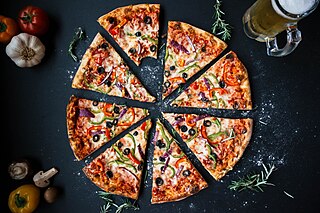
Pizza is a dish of Italian origin consisting of a usually round, flat base of leavened wheat-based dough topped with tomatoes, cheese, and often various other ingredients, which is then baked at a high temperature, traditionally in a wood-fired oven.

Baking is a method of preparing food that uses dry heat, typically in an oven, but can also be done in hot ashes, or on hot stones. The most common baked item is bread, but many other types of foods can be baked. Heat is gradually transferred "from the surface of cakes, cookies, and pieces of bread to their center. As heat travels through, it transforms batters and doughs into baked goods and more with a firm dry crust and a softer center". Baking can be combined with grilling to produce a hybrid barbecue variant by using both methods simultaneously, or one after the other. Baking is related to barbecuing because the concept of the masonry oven is similar to that of a smoke pit.

Pastry is baked food made with a dough of flour, water, and shortening that may be savoury or sweetened. Sweetened pastries are often described as bakers' confectionery. The word "pastries" suggests many kinds of baked products made from ingredients such as flour, sugar, milk, butter, shortening, baking powder, and eggs. Small tarts and other sweet baked products are called pastries as a synecdoche. Common pastry dishes include pies, tarts, quiches, croissants, and pasties.

A croissant is a French pastry made from puff pastry in a crescent shape.

A baker is a tradesperson who bakes and sometimes sells breads and other products made of flour by using an oven or other concentrated heat source. The place where a baker works is called a bakery.

Dough is a thick, malleable, sometimes elastic paste made from grains or from leguminous or chestnut crops. Dough is typically made by mixing flour with a small amount of water or other liquid and sometimes includes yeast or other leavening agents, as well as ingredients such as fats or flavorings.

A bakery is an establishment that produces and sells flour-based food baked in an oven such as bread, cookies, cakes, doughnuts, bagels, pastries, and pies. Some retail bakeries are also categorized as cafés, serving coffee and tea to customers who wish to consume the baked goods on the premises. Confectionery items are also made in most bakeries throughout the world.

A calzone is an Italian oven-baked turnover, made with leavened dough. It originated in Naples in the 18th century. A typical calzone is made from salted bread dough, baked in an oven and is stuffed with salami, ham or vegetables, mozzarella, ricotta and Parmesan or pecorino cheese, as well as an egg. Different regional variations in or on a calzone can often include other ingredients that are normally associated with pizza toppings. The term usually applies to an oven-baked turnover rather than a fried pastry, though calzoni and panzerotti are often mistaken for each other.

Quick bread is any bread leavened with a chemical leavening agent rather than a biological one like yeast or sourdough starter. An advantage of quick breads is their ability to be prepared quickly and reliably, without requiring the time-consuming skilled labor and the climate control needed for traditional yeast breads.
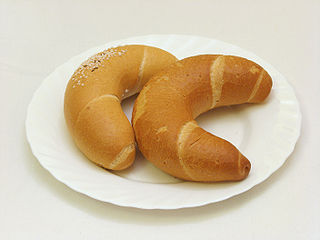
Kifli, kiflice, kifle, or kipferl is a traditional yeast bread roll that is rolled and formed into a crescent before baking.

A roller docker, rolling docker, dough docker, roto-fork, or simply docker is a food preparation utensil which resembles either a small, spiked rolling pin, or a small rotary tiller. It is used to pierce bread dough, cracker dough, pizza dough or pastry dough to prevent over rising or blistering. This specialized tool is more commonly found in professional bakeries than in homes that only do light or occasional baking.
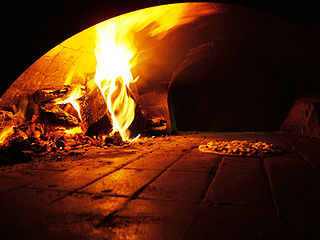
A masonry oven, colloquially known as a brick oven or stone oven, is an oven consisting of a baking chamber made of fireproof brick, concrete, stone, clay, or cob. Though traditionally wood-fired, coal-fired ovens were common in the 19th century, and modern masonry ovens are often fired with natural gas or even electricity. Modern masonry ovens are closely associated with artisan bread and pizza, but in the past they were used for any cooking task involving baking. Masonry ovens are built by masons.

A sheet pan, also referred to as baking tray, baking sheet, or baking pan, is a flat, rectangular metal pan placed in an oven and used for baking pastries such as bread rolls, cookies, sheet cakes, Swiss rolls, and pizzas.
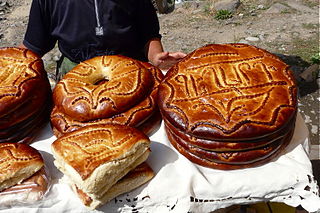
Gata is an Armenian pastry or sweet bread. There are many variations of gata in Armenia. Typically, specific towns or regions will have their own version. It can be found in a variety of shapes, sizes and may be decorated or left unadorned. Long ago, gata was baked in a tonir, but it is now baked in ovens. The bread is traditionally eaten at the feast of Candlemas, but is eaten during other festivities too or simply baked to enjoy with a cup of tea or coffee.
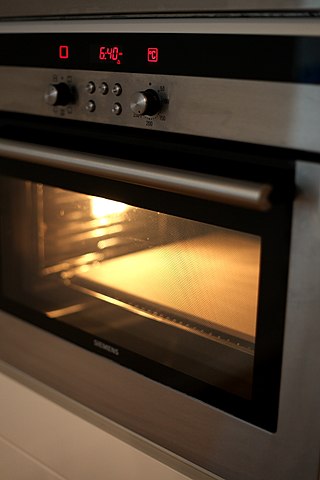
A baking stone is a portable cooking surface used in baking. It may be made of ceramic, stone or, more recently, salt. Food is put on the stone, which is then placed in an oven, though sometimes the stone is heated first. Baking stones are used much like cookie sheets, but may absorb additional moisture for crispier food. A pizza stone is a baking stone designed for cooking pizza.

A kitchen scraper is a kitchen implement made of metal, plastics, wood, rubber or silicone rubber. In practice, one type of scraper is often interchanged with another or with a spatula for some of the various uses.

Mexican breads and other baked goods are the result of centuries of experimentation and the blending of influence from various European baking traditions. Wheat, and bread baked from it, was introduced by the Spanish at the time of the Conquest. The French influence in Mexican Bread is the strongest. From the bolillo evolving from a French baguette to the concha branching out from a French brioche even the terminology comes from France. A baño maría, meaning a water bath for a custard type budín or bread pudding comes from the French word bain marie. While the consumption of wheat has never surpassed that of corn in the country, wheat is still a staple food and an important part of everyday and special rituals. While Mexico has adopted various bread styles from Europe and the United States, most of the hundreds of varieties of breads made in the country were developed here. However, there is little to no baking done in Mexican homes; instead, Mexicans have bought their baked goods from bakeries since the colonial period.

Straight dough is a single-mix process of making bread. The dough is made from all fresh ingredients, and they are all placed together and combined in one kneading or mixing session. After mixing, a bulk fermentation rest of about 1 hour or longer occurs before division. It is also called the direct dough method.
Baking was a popular profession and source of food in ancient Rome. Many ancient Roman baking techniques were developed due to Greek bakers who traveled to Rome following the Third Macedonian War. Ancient Roman bakers could make large quantities of money. This may have contributed to receiving a negative reputation. Bakers used tools such as the fornax, testum, thermospodium, and the clibanus to make bread. Most Roman breads were made using sourdough. The most common way to leaven bread was using flour mixed with grain.




















